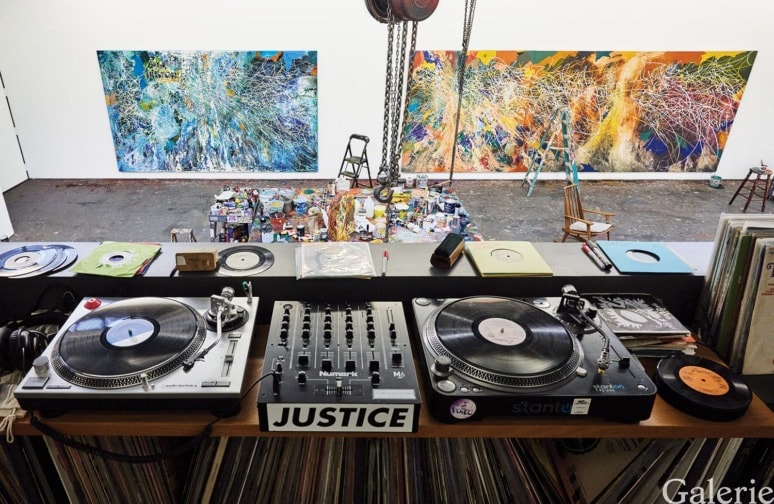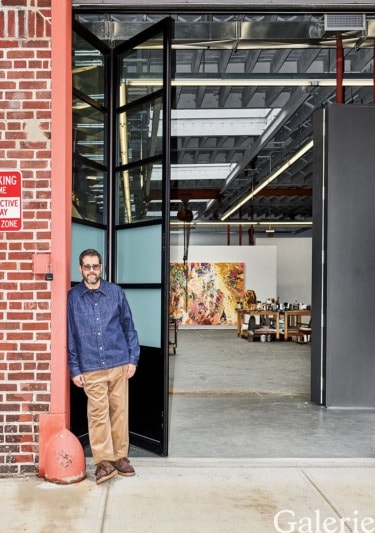José Parlá Opens Up His Brooklyn Studio Ahead of His Major Show at the Pérez Art Museum Miami
For his first solo museum exhibition in his native Miami, the free-spirited artist lets it rip with some of the largest and most exuberant paintings of his career

A decade ago, José Parlá needed a studio large enough to create the biggest commission of his career up till then—a 90-foot-wide mural for the lobby of One World Trade Center. The Miami-born, Brooklyn-based artist of Cuban descent was still a rising star, gaining recognition for his work melding the calligraphic dynamism of street art and Abstract Expressionism in monumental permanent commissions for the Brooklyn Academy of Music and nearby Barclays Center. Parlá found a vast, low-slung warehouse in the Gowanus area of Brooklyn and, with the help of the architecture firm Snøhetta, transformed it into a flexible workspace-cum-showplace with the scale and finish of a blue-chip Chelsea gallery, an ambitious gambit that has paid off.

“It was an investment in the future with the vision of what we could produce—you know, build it and they will come,” says the gregarious, energetic artist, flipping vinyl records from his Afro-Cuban music collection in a lounge-like mezzanine area during a recent visit to his studio. This perch, which he calls the “nest,” overlooks the “arena,” a cavernous double-height workspace with pivoting walls and a ribbon of skylights that is ringed with eight massive, vibrantly colored canvases that were two and a half years in the making.
Created in the aftermath of Parlá’s long recovery from a life-threatening case of COVID in 2021, when he was placed in a medically induced coma for four months, these works are the centerpiece of his exhibition “Homecoming,” at the Pérez Art Museum Miami through July 6. Parlá’s first major institutional show in his hometown, it also celebrates his return to his studio, to his health, to his vitality as an artist.
“This is a homecoming in the literal sense of coming home with a body of work that is in conversation with not only Miami but also the region that is such a center for Latin American and Caribbean culture,” says Parlá. He points to two 14-foot-long paintings with verdant, tropical palettes suggestive of land and sea and embedded with fragments of posters and advertisements he excavated from walls in Miami. Collaged bits of text and faces peer out from encrusted layers of plaster and paint, bristling with dense networks of arcing lines that bring to mind migration routes as well as the circulatory system. “I was still healing,” he says, “and really conscious of the body and the skin and what’s inside the skin.”
For two days in late October, before the exhibition opened, the Pérez invited museum visitors to watch Parlá working in real time to finish a painting titled Homecoming; Before Time, The First Migrations, which situates the island of Cuba at the center of a roiling prehistoric seascape. Working with his usual studio table, ladder, trolley, chairs, record collection, and turntable—all brought from Brooklyn—the artist applied the final arabesque flourishes to the 28-foot-wide canvas in front of the public.


“With José, it’s like this dance,” says Maritza Lacayo, the Pérez associate curator who organized “Homecoming” and considers Parlá’s physical process fundamental to understanding his paintings. “I see them as the remnants of a performance. It requires him to climb up high on the ladder, jump off the ladder, add layers, tear layers off, all while he’s playing music.” The studio components will remain in the gallery for the duration of the show, which also includes older paintings as well as photos and sketchbooks from the 1980s and ’90s, when Parlá was painting graffiti on walls with friends in Miami, where he was born in 1973.


Parlá spent his early youth in Puerto Rico before moving back to Miami at age ten with his family, when he experienced racism for the first time. As a teenager, he found a sense of refuge in hip-hop culture. “I was beatboxing, learning how to DJ, painting in the park—it was all one art form,” he says, also noting an early affinity for calligraphic writing, rapping, and breakdancing.


Parlá’s high school art teacher changed his life when she entered one of his paintings in the Scholastic Art Awards competition and he won a scholarship to the Savannah College of Art and Design. There, he began to look at the work of artists like Cy Twombly, Robert Rauschenberg, and Joan Mitchell and connected their gestural mark making with the phenomenon of urban graffiti.

The soaring abstracted script he brings to his paintings now “is still very true to my roots,” says Parlá, who refers to his calligraphic language as a form of liberation. “As a painter, everything you’re absorbing in life—the difficulties, the politics, the news—the studio is the place to work all of that out. And it is a workout.”
A version of this article first appeared in print in our 2024/25 Winter Issue under the headline “Joy Ride.” Subscribe to the magazine.
